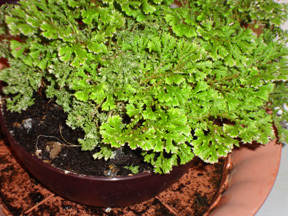Question avitar
avitar
QUESTION: I recently purchased a beautiful potted plant called an avitar fern. It was supposed to be a combo fern and moss. It was advertised as a low light container plant that needed little care. In a dimly lit room it is doing poorly, and the edges of the leaves? are turning pale. It roots by putting down roots from the stems. There were no names other than Avitar. The leaf clusters have the shape of a geranium, but they look more like an evergreen. Any ideas?
ANSWER: Mary hi;
Thanks for the photo; without it, I would not have had a clue!
The plant you have is in the genus Selaginella, otherwise known as spikemoss. Technically, it is a moss (not a fern) but it is often grouped with ferns due to their many shared characteristics. From the photo, I cannot say for sure which spikemoss it is. I wonder if you could forward a picture of the tag that came with it?
Also, I suspect the name "Avitar" is some sort of marketing idea, because it is not any kind of proper taxonomic (scientific) name that I have heard of.
As to the plant health, there are two things I can come up with. First, the pale tips and roots from the leaves are perfectly normal and part of the plant habit, especially in winter. These are parts of the aesthetic allure of the plant. Some people actually refer to it as 'gold-tip'.
Second, and this is an extremely common misconception: plants that are categorized as "low-light" actually require plenty of natural light in the home. The term "low-light" used on the tags refers to the outdoor environment. If you kept this plant outside, it would need to be under the canopy of other plants and protected from the cold. Our typical indoor environment contains a mere fraction of natural outdoor light. Accordingly, literally all foliage plants that are kept indoors will thrive where we have skylights or large windows.
I would recommend moving this plant to the best lit room in the house, as long as it does not receive any direct mid day sun. Also, in the photo, it does not appear to need water right now but as it gets more light, it might. This plant does not like to dry out, but also shouldn't be soggy wet. I am confident you will see improvement after a while.
Thanks for your great question!
DC
---------- FOLLOW-UP ----------
QUESTION: Thanks for the info. I will move it to a new location and hopefully that will help. I laid it in a sunny spot near a window, and now the cat is nibbling on the leaves. I've never seen her eat a plant, is it related to catnip? Just wondering.
AnswerThis plant is not related to catnip (which is a flowering plant). Also, all records I could find list it as non-toxic to cats; I hope that is truly the case.
In its new spot, the plant may need more water so I would check frequently. I would say check twice a week and water as needed, when the plant is moderately moist but not fully dry.
DC






